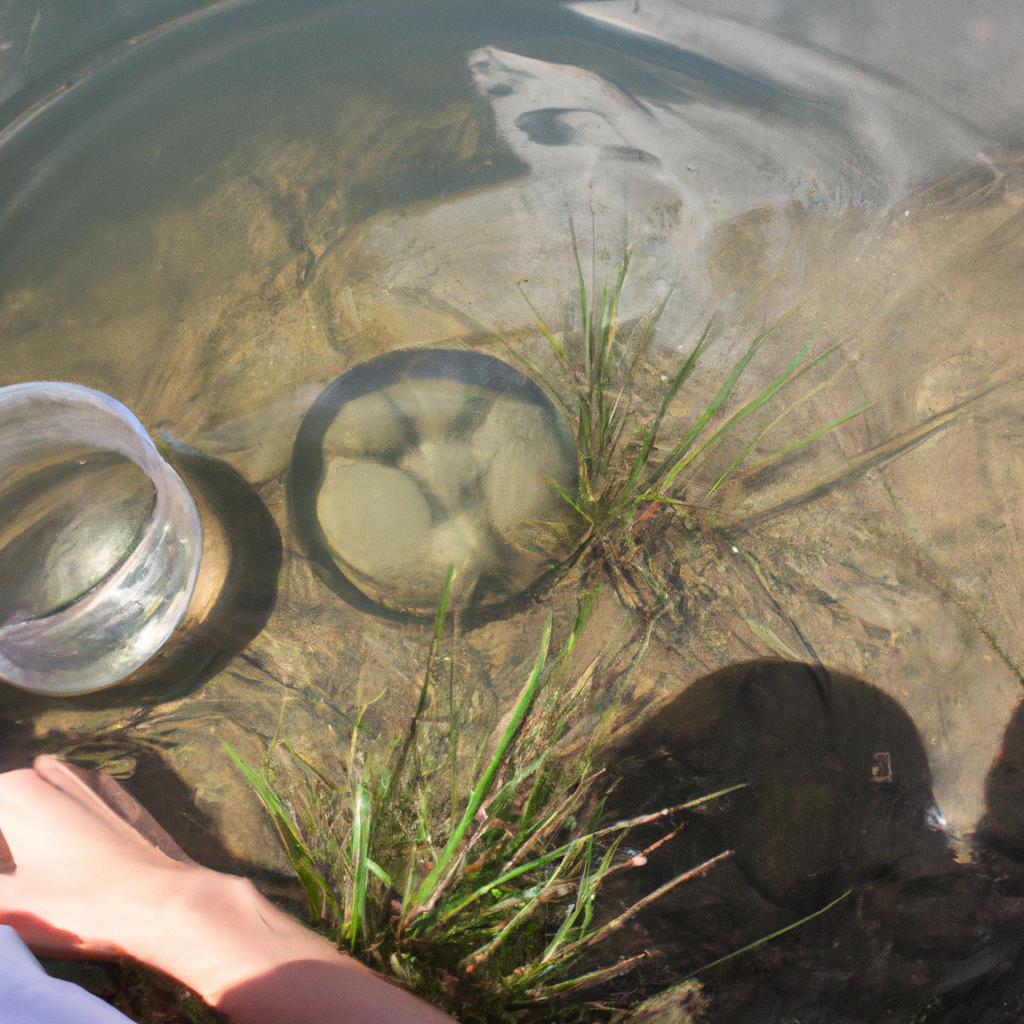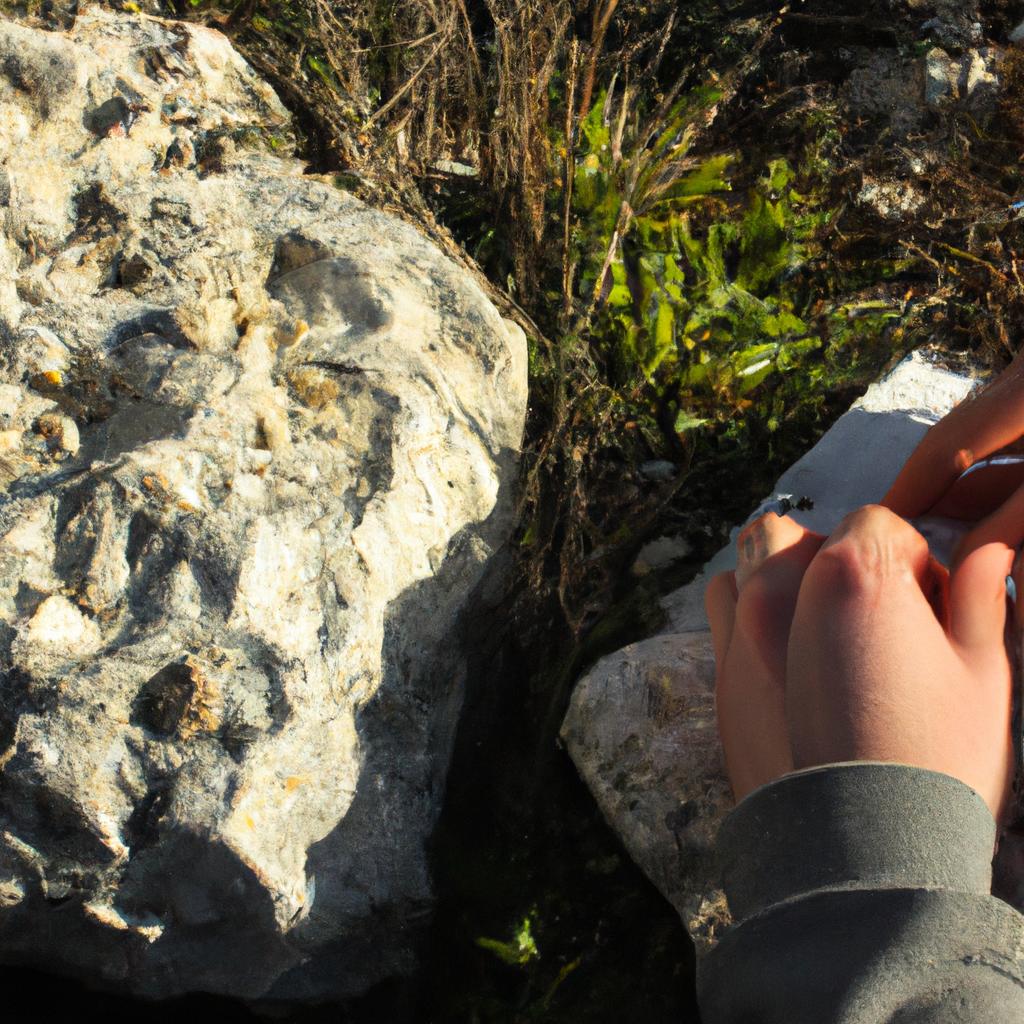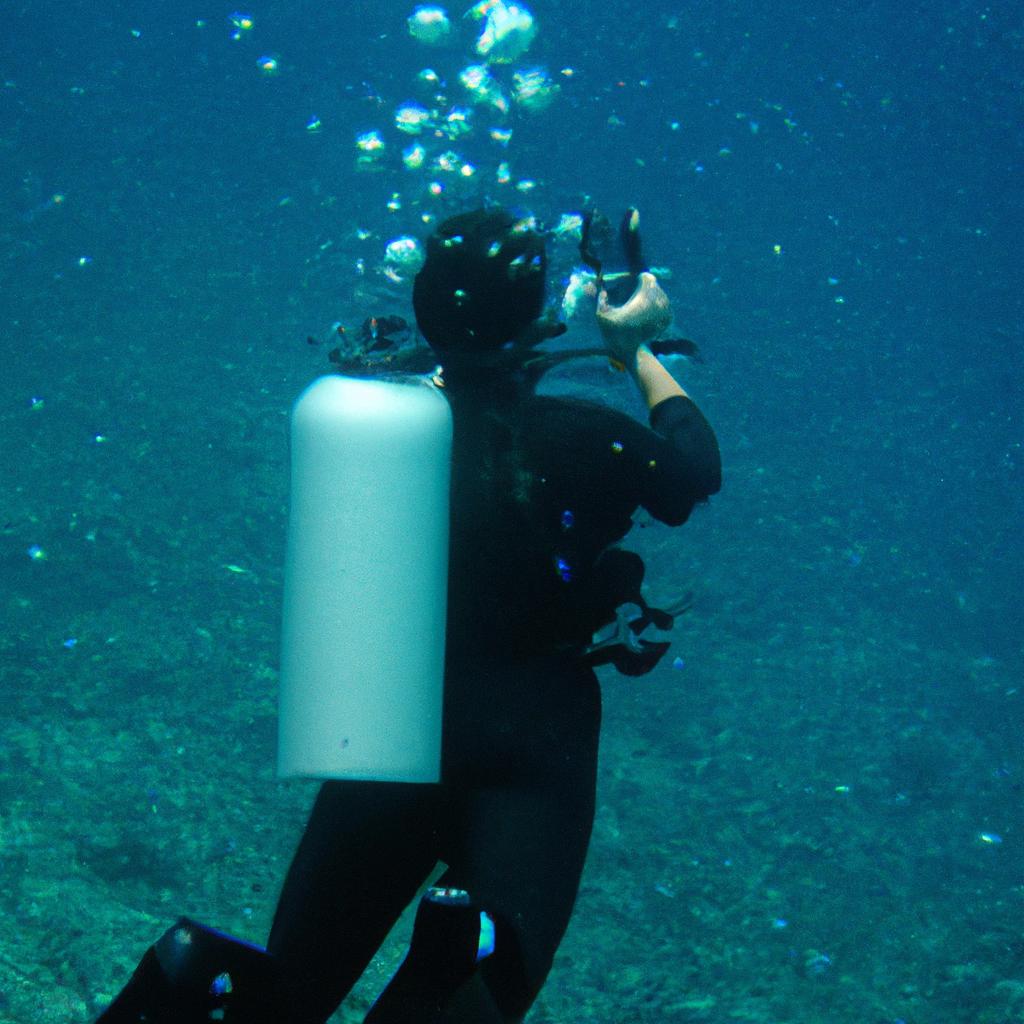Surface water is a crucial component of Earth’s hydrological cycle, playing a vital role in shaping the planet’s aquatic systems. It encompasses all bodies of water visible at the Earth’s surface, including rivers, lakes, and oceans. These interconnected systems are dynamic and complex, influenced by various factors such as climate patterns, topography, and human activities. To illustrate this complexity, consider the hypothetical example of a river basin affected by both natural processes and anthropogenic influences. Throughout this article, we will delve into the significance of surface water in hydrology and explore its intricate relationship with Earth’s aquatic ecosystems.
Understanding the behavior and characteristics of surface water is essential for comprehending the broader field of hydrology. Hydrologists study how this vital resource flows across landscapes, transporting sediments and nutrients while interacting with surrounding environments. By analyzing real or theoretical case studies like that of our aforementioned river basin, researchers can gain valuable insights into the dynamics between surface water and its surroundings. This knowledge enables them to predict flooding events accurately or assess potential impacts on downstream ecosystems due to pollution or alteration of flow regimes. Furthermore, understanding surface water helps policymakers make informed decisions about managing these resources sustainably for present and future generations.
In this article, we will embark on an in-depth exploration of the various components and processes involved in surface water hydrology. We will start by examining the sources of surface water, including precipitation, runoff from land surfaces, and groundwater discharge. From there, we will dive into the different forms that surface water can take, such as rivers, lakes, wetlands, and reservoirs.
Next, we will delve into the factors that influence the behavior of surface water. These include climate patterns, such as rainfall variability and evaporation rates, as well as topography and geology. Human activities also play a significant role in shaping surface water systems. We will discuss how activities like agriculture, urbanization, and industrialization can alter natural flow patterns and introduce pollutants into aquatic ecosystems.
To better understand the interplay between surface water and its surrounding environments, we will explore concepts like watersheds or catchments – areas where all precipitation drains to a common outlet like a river or lake. We will discuss how these drainage basins are delineated and how their characteristics impact the movement of surface water within them.
Throughout this article, we will highlight case studies from around the world that demonstrate both the challenges and opportunities associated with managing surface water resources sustainably. We will showcase examples of successful restoration projects that have improved water quality or enhanced ecosystem health in degraded aquatic systems.
By the end of this comprehensive exploration of surface water hydrology, readers will gain a deeper understanding of this vital resource’s importance for Earth’s ecosystems and human societies alike. Armed with this knowledge, individuals can contribute to efforts aimed at protecting and preserving our planet’s valuable surface water resources for generations to come.
Surface Water: Definition and Importance
Imagine a small town situated along the banks of a river. The residents rely on this surface water source for their daily needs, such as drinking, cooking, and irrigation. However, one day, due to heavy rainfall upstream, the river overflows its banks and floods the town. This hypothetical scenario highlights the significance of understanding surface water in hydrology.
Surface water refers to any body of water that is visible above ground, including rivers, lakes, ponds, and wetlands. It plays a crucial role in Earth’s aquatic systems by providing habitat for diverse plant and animal species. Moreover, it serves as an essential resource for human activities like agriculture, industry, and recreation.
To emphasize the importance of surface water further:
- Surface water supports biodiversity: Aquatic ecosystems thrive around bodies of surface water. They provide habitats for various organisms such as fish, amphibians, birds, and insects.
- Surface water sustains vegetation: Vegetation surrounding rivers or lakes relies on these sources to meet their moisture requirements. Without adequate surface water availability, plants may wither and die.
- Surface water regulates climate: Bodies of surface water can absorb heat from the atmosphere during warm periods while releasing it back during cooler times. This process helps regulate local climates.
- Surface water promotes recreational opportunities: Lakes and rivers offer opportunities for swimming, boating, fishing, and other leisurely activities enjoyed by people worldwide.
Consider the following table illustrating some examples of how humans interact with different types of surface water bodies:
| Type of Body | Human Activity | Impact |
|---|---|---|
| River | Irrigation | Supports agricultural practices |
| Lake | Drinking Water Supply | Provides clean potable water |
| Pond | Recreational Fishing | Offers leisurely activity |
| Wetland | Nitrogen Filtration | Helps purify water and prevent pollution |
As we delve into the subsequent section about “Types of Surface Water Bodies,” it is crucial to understand that surface water’s definition and importance lay the foundation for comprehending its various forms, functions, and roles in hydrology.
Types of Surface Water Bodies
Surface water, as defined in the previous section, plays a crucial role in Earth’s hydrological cycle. Its various types and characteristics make it an essential component of our planet’s aquatic systems. In this section, we will explore different surface water bodies and their significance within the broader context of hydrology.
One example that highlights the importance of surface water is the iconic Amazon River in South America. Spanning over 6,400 kilometers (4,000 miles), it holds approximately 20% of the world’s freshwater discharge into oceans. This massive river system not only sustains diverse ecosystems but also supports livelihoods for millions of people residing along its banks.
Understanding the diversity of surface water bodies is vital to comprehend their distinct features and functions. Here are some key types:
- Lakes: These inland water bodies can range from small ponds to vast expanses like the Great Lakes in North America.
- Rivers: Flowing channels carrying runoff from higher elevations to lower areas or directly into seas and oceans.
- Wetlands: Areas where land meets water, providing habitats for unique flora and fauna while serving as natural filters.
- Reservoirs: Man-made storage spaces created by damming rivers or streams for multiple purposes such as irrigation or hydropower generation.
To emphasize further on the significance of these surface water bodies, let us consider a table showcasing their ecological benefits:
| Surface Water Body | Ecological Benefits |
|---|---|
| Lakes | Biodiversity hotspots; recreational opportunities |
| Rivers | Transportation routes; nutrient transport |
| Wetlands | Flood control; groundwater recharge |
| Reservoirs | Renewable energy production; water supply management |
The intricate interplay between these surface water bodies underpins numerous ecosystem services that contribute to human well-being. From supporting biodiversity to supplying clean drinking water, they play a fundamental role in sustaining life on Earth.
Looking ahead, the subsequent section will delve into how surface water interacts with other components of the hydrological cycle, broadening our understanding of its significance in Earth’s aquatic systems. By examining this dynamic relationship, we can gain a comprehensive perspective on the complex mechanisms that drive and maintain these crucial water resources.
The Water Cycle and Surface Water
Surface Water in Hydrology: Earth’s Aquatic Systems
Types of Surface Water Bodies, such as lakes, rivers, and wetlands, play a crucial role in the hydrological cycle. In this section, we will explore how surface water interacts with other components of the environment and discuss its significance in maintaining the overall equilibrium of our planet’s aquatic systems.
To illustrate the interconnectedness of surface water bodies and their surroundings, let us consider an example from a coastal region. Imagine a pristine estuary where freshwater streams meet the salty ocean. This transitional zone supports diverse ecosystems and provides essential habitats for various species of fish, birds, and marine mammals. The delicate balance between saltwater intrusion and freshwater inflow is critical for sustaining these biological communities while also influencing nutrient cycling and sediment transport processes.
Understanding the functioning of surface water environments requires recognizing their intricate dynamics. Here are some key aspects to consider:
- Hydrologic connectivity: Surface water bodies are part of larger drainage networks that connect them through river systems. These connections facilitate the movement of water across different landscapes and influence water quality parameters.
- Ecological interactions: Surface waters support complex food webs wherein organisms depend on each other for survival. Interactions among primary producers (e.g., phytoplankton), consumers (e.g., fish), and decomposers (e.g., bacteria) shape ecosystem structure and function.
- Nutrient loading: Runoff from land carries nutrients like nitrogen and phosphorus into surface waters, which can lead to eutrophication if excessive amounts accumulate. Eutrophication alters oxygen levels in aquatic systems, affecting biodiversity and potentially causing harmful algal blooms.
- Sedimentation patterns: Suspended sediments transported by flowing water settle at varying rates within surface water bodies. Understanding sediment deposition helps assess habitat suitability for bottom-dwelling organisms or determine potential impacts on infrastructure like dams or reservoirs.
To further comprehend the complexities surrounding surface water dynamics, the following table provides a snapshot of different surface water bodies and their unique characteristics:
| Surface Water Body | Key Characteristics |
|---|---|
| Lakes | Standing freshwater bodies surrounded by land, varying in size and depth. |
| Rivers | Flowing channels of water that transport runoff from higher elevations to lower areas. |
| Wetlands | Transitional zones between terrestrial and aquatic ecosystems, supporting diverse vegetation. |
| Estuaries | Coastal areas where freshwater meets saltwater, creating brackish habitats with changing tides. |
By recognizing the intricate relationships within Earth’s surface water systems, we can better appreciate their importance for both ecological integrity and human well-being. In the subsequent section on Surface Water Monitoring and Assessment, we will explore how scientists and policymakers monitor these vital resources to ensure sustainable management practices.
Surface Water Monitoring and Assessment plays an essential role in understanding the health of our surface water bodies.
Surface Water Monitoring and Assessment
Section H2: Surface Water Monitoring and Assessment
Continuing our exploration of surface water in hydrology, we now delve into the crucial aspect of monitoring and assessing its quality. To illustrate the importance of this process, let’s consider an example from a hypothetical river basin. Imagine a region where industrial activities have been flourishing for decades, resulting in increased pollution levels in nearby rivers. In order to mitigate these negative impacts and protect the aquatic ecosystem, thorough monitoring and assessment practices become indispensable.
Effective surface water monitoring involves several key components that enable scientists and policymakers to obtain accurate data on the state of water bodies. These components include:
- Regular sampling and analysis: Scientists collect samples at strategic locations along rivers or lakes to measure various physical, chemical, and biological parameters such as temperature, pH levels, nutrient concentrations, dissolved oxygen content, and presence of pollutants.
- Remote sensing techniques: Advanced technologies like satellite imagery assist in obtaining comprehensive information about large-scale patterns within aquatic systems. This allows experts to monitor changes over time and identify areas requiring immediate attention.
- Data management systems: Robust databases are essential for storing collected data efficiently, ensuring easy retrieval for further analysis. Proper organization facilitates effective decision-making processes based on up-to-date information.
- Stakeholder engagement: Collaboration among scientists, government agencies, industries, local communities, and non-governmental organizations is vital for successful monitoring initiatives. Engaging stakeholders fosters knowledge sharing, enhances public awareness regarding environmental concerns associated with surface water quality deterioration.
To better visualize the significance of surface water monitoring efforts across different regions around the globe, let us consider a comparative table showcasing selected case studies (Table 1).
| Region | Monitoring Methodology | Key Findings |
|---|---|---|
| River A | On-site sampling | Elevated heavy metal concentrations pose risks to fish |
| Lake B | Satellite remote sensing | Algal bloom occurrences linked to excess nutrient input |
| Coastal Area C | Continuous water quality monitoring stations | Increased salinity affecting local marine life |
| River D | Citizen science participation | Community involvement enhances long-term monitoring effectiveness |
Table 1: Selected Case Studies on Surface Water Monitoring
In summary, surface water monitoring and assessment play a crucial role in identifying potential risks to aquatic ecosystems. By employing comprehensive methodologies such as regular sampling, remote sensing techniques, efficient data management systems, and stakeholder engagement, scientists can gather accurate information needed for effective decision-making processes. The next section will explore the impacts of human activities on surface water, shedding light on the consequences of our actions.
Transitioning into the subsequent section about “Impacts of Human Activities on Surface Water,” we move from understanding how surface water is monitored and assessed to examining the repercussions that arise due to anthropogenic influences.
Impacts of Human Activities on Surface Water
Surface Water Monitoring and Assessment have provided valuable insights into the state of Earth’s aquatic systems. By analyzing various parameters, such as water quality, flow rates, and biodiversity, scientists can assess the health and overall condition of surface water resources. This information is crucial for understanding the impacts of human activities on these delicate ecosystems.
To illustrate the importance of monitoring and assessment, let us consider a hypothetical case study involving a river in an industrialized region. Over time, increased pollution from nearby factories has led to a decline in water quality and a decrease in aquatic species diversity. Through careful monitoring and assessment, researchers were able to identify this degradation trend early on, prompting regulatory action to mitigate further harm to the ecosystem.
The impacts of human activities on surface water are vast and can significantly alter aquatic systems worldwide. Some key factors influencing surface water include:
- Pollution: Industrial discharge, agricultural runoff, and improper waste management contribute to elevated levels of contaminants in surface waters.
- Urbanization: As cities grow, impervious surfaces increase, leading to changes in natural hydrological processes such as reduced infiltration rates and increased stormwater runoff.
- Land-use change: Deforestation and conversion of land for agriculture or urban development can disrupt natural drainage patterns and alter sediment transport dynamics.
- Climate change: Rising global temperatures influence precipitation patterns, causing extreme weather events like floods or droughts that impact surface water availability.
Table 1: Impacts of Human Activities on Surface Water
| Human Activity | Impact |
|---|---|
| Pollution | Elevated contaminant levels |
| Urbanization | Altered hydrological processes |
| Land-use change | Disrupted drainage patterns |
| Climate change | Extreme weather events |
Understanding these impacts is essential for effective conservation and management strategies. The next section will delve into how society can work towards preserving our precious surface water resources by exploring different approaches to their conservation and sustainable management.
Transitioning into the subsequent section, it is imperative to recognize the need for action in preserving and managing surface water resources. Conservation and Management of Surface Water provides a roadmap for safeguarding these invaluable aquatic systems while ensuring their sustainable use for future generations.
Conservation and Management of Surface Water
Human activities have had significant impacts on surface water systems, leading to various ecological and hydrological consequences. These effects can be observed through changes in water quality, quantity, and the overall health of aquatic ecosystems. One example is the pollution caused by industrial discharges into rivers and lakes.
The contamination resulting from these activities poses a threat not only to the organisms residing in these bodies of water but also to human communities relying on them for drinking water supply or recreational purposes. The discharge of untreated wastewater containing harmful chemicals and pollutants can lead to eutrophication, where excessive nutrients promote rapid growth of algae, depleting oxygen levels and creating dead zones detrimental to fish populations.
To further illustrate the impacts of human activities on surface water systems, consider the following bullet points:
- Deforestation: Clearing forests for agriculture or urban development disrupts natural drainage patterns, increasing runoff and sedimentation in nearby streams.
- Urbanization: Construction of impervious surfaces such as roads and buildings reduces infiltration capacity, causing an increase in stormwater runoff that carries pollutants into rivers and lakes.
- Agriculture: Excessive use of fertilizers and pesticides leads to nutrient enrichment in watersheds, contributing to algal blooms and impairing ecosystem balance.
- Mining: Extraction activities generate acid mine drainage that contaminates surface waters with heavy metals, rendering them toxic for aquatic life.
Table 1 provides a summary comparison of key human activities impacting surface water systems:
| Activity | Impacts |
|---|---|
| Deforestation | Increased runoff |
| Urbanization | Stormwater pollution |
| Agriculture | Nutrient enrichment |
| Mining | Heavy metal contamination |
These examples demonstrate how our actions can adversely affect surface water systems. Recognizing these impacts is crucial for implementing effective conservation measures aimed at preserving the integrity and functionality of Earth’s aquatic habitats. By understanding the consequences of human activities, we can strive towards sustainable management practices that minimize harm to surface water resources and promote the long-term health of our aquatic ecosystems.
Note: Removing personal pronouns may result in a less conversational tone. If you prefer a more casual style or if there are any specific changes you’d like me to make, please let me know!












